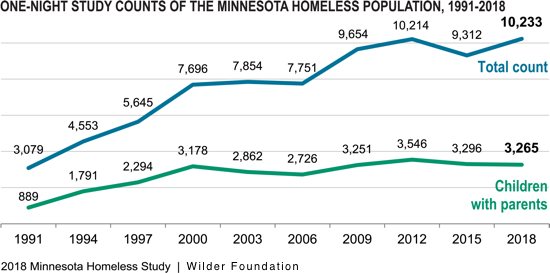The number of people without a home in Minnesota hit a record high last year: 10,233.
That’s up 10 percent from 9,312 in 2015, and back up to the then-record 10,214 counted in 2012, according to the research arm of the Amherst H. Wilder Foundation of St. Paul, a nonprofit community organization that has conducted the statewide study every three years since 1991.
And those numbers, based on thousands of one-day, face-to-face interviews Oct. 25 with people in emergency shelters, transitional housing or found in encampments, hot-meal programs and other drop-in sites, don’t include an estimate of the uncounted homeless, which will be released this fall.
In 2015, Wilder Research estimated a total of 15,000 counted and uncounted homeless in the state on any given night, and nearly 40,000 — or about 0.7 percent of the state’s 5.6 million people — experiencing homelessness at some point that year.
One reason the number of counted homeless climbed last year was higher visibility of people on the streets that fall, including large encampments in St. Paul and Minneapolis and people riding the light rail that runs between the two cities, said Greg Owen, consulting scientist and a retired research manager with the foundation, who has helped conduct the survey since its inception in 1984, when it was confined to the metropolitan area.
But that’s not the only reason, Owen said.
“The study suggests other things, too — what I would call a concentration of distress and stress factors that contribute to barriers to getting stable housing for people,” he said.
Reports from Wilder teasing out those details will be published in coming months. But reasons cited for homelessness in the past — and expected to continue in the current survey — include lack of affordable housing, mental health problems and other chronic health conditions, domestic violence and broken relationships, Owen said.
Released in March, the one-night count already shows that the number of homeless children and youth age 24 and younger made up 46 percent — nearly half — of Minnesota’s homeless population, both last year and in 2015; the number of homeless adults increased by 25 percent last year compared with 2015, with a particular spike among those 55 and older; and the number of people not in a formal shelter increased by 62 percent.
Similar to 2015, about 66 percent of the state’s homeless lived in the Twin Cities last year; about 34 percent lived outside the metropolitan area, the study found.
One difficulty that has increased over the years, Owen said, is that lower-cost housing is not the only answer. Often people who are homeless also have mental health or other challenges, and the services needed to help them stay healthy and in their homes are not readily available, he said.
“It’s not that we shouldn’t have housing, but housing alone without support is a problem,” he said.
Wilder’s studies, conducted every three years because of their complexity and the logistics involved, show a general increase in homelessness since 1991, when 3,079 people were counted as homeless. Reasons include the closing of state hospitals and mental institutions in the 1970s in favor of community-based care that didn’t take into account the need to house people who were suffering from mental illness, Owen said.
In the 1990s, the federal Department of Housing and Urban Development stopped building affordable, Section 8 housing, in favor of the private sector stepping in, Owen said.
But “we do not have a (housing) market that responds to the kind of incentives the federal government is giving us,” he said.
A third reason for the rising number of homeless is private development taking out many of the old hotels and less expensive apartments in favor of higher-end, higher-cost housing, forcing residents onto the streets and pushing up the overall cost of rent and a mortgage, Owen said.
“We’ve not really created a kind of large, systemic strategy for low-income housing, and there are serious barriers to people living on their own,” Owen said. “We’ve closed the door.”
 The Catholic Spirit is taking a four-part, multi-faceted look this year at homelessness in Minnesota and the ways agencies, governments and people work to prevent and eliminate homelessness.
The Catholic Spirit is taking a four-part, multi-faceted look this year at homelessness in Minnesota and the ways agencies, governments and people work to prevent and eliminate homelessness.




